Last update: 11/18/2023
There are a wonderful and growing array of hydrophones monitoring the ocean soundscapes of British Columbia, Canada. This post provides an overview of them with shortcuts in a brief listening guide. In future posts, we’ll describe how to access and listen to recordings from each location.
In a few cases, listening live is also possible (see TLDR; banners for each section). Since Orcasound is focused on real time bioacoustics, we list the sites with live-listening opportunities first.
Raincoast | SIMRES | Orca Lab | ONC | Pacific Wild | BC Whales

Raincoast hydrophone — in the Interim Sanctuary Zone off North Pender
TLDR; As November, 2023, Raincoast provides a YouTube live stream of a hydrophone and in-air web cam.
On Halloween (10/31) in 2023, Raincoast announced the deployment of a hydrophone in Swanson Channel with a webcam perched on the SW corner of North Pender Island. They provide what appears to be a real time feed via this YouTube live stream:
On Saturday, November 18, 2023, Monika Wieland Shields shared on the Whale Sightings in the San Juans Facebook group that she was hearing calls from J, K, and L pod and seeing the SRKWs northbound in the video feed. Here is are examples of video frames showing northbound fins (screenshots by Scott Veirs via playback of live stream recording):
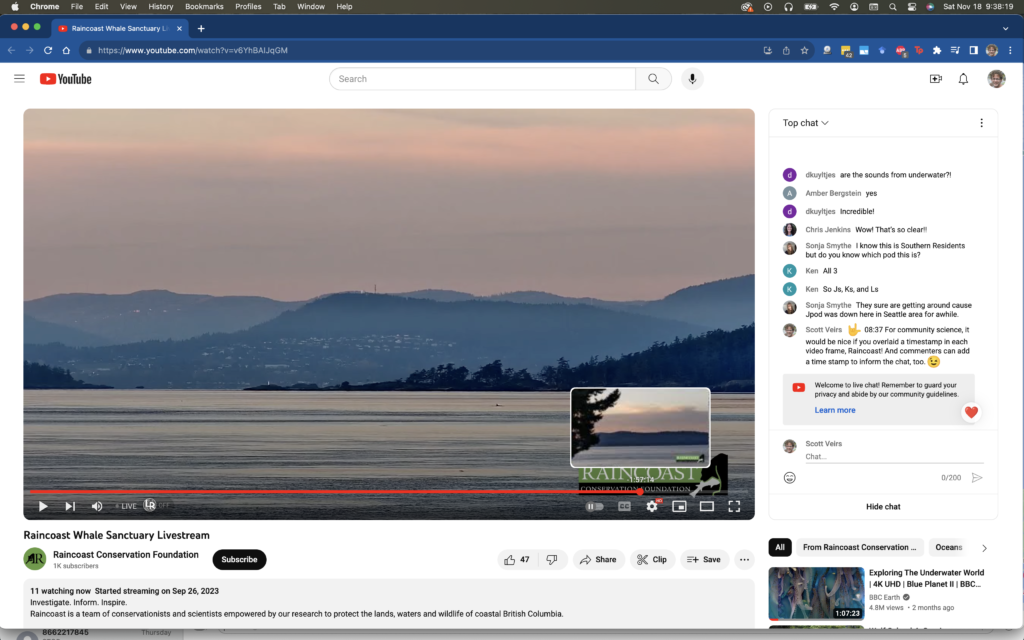

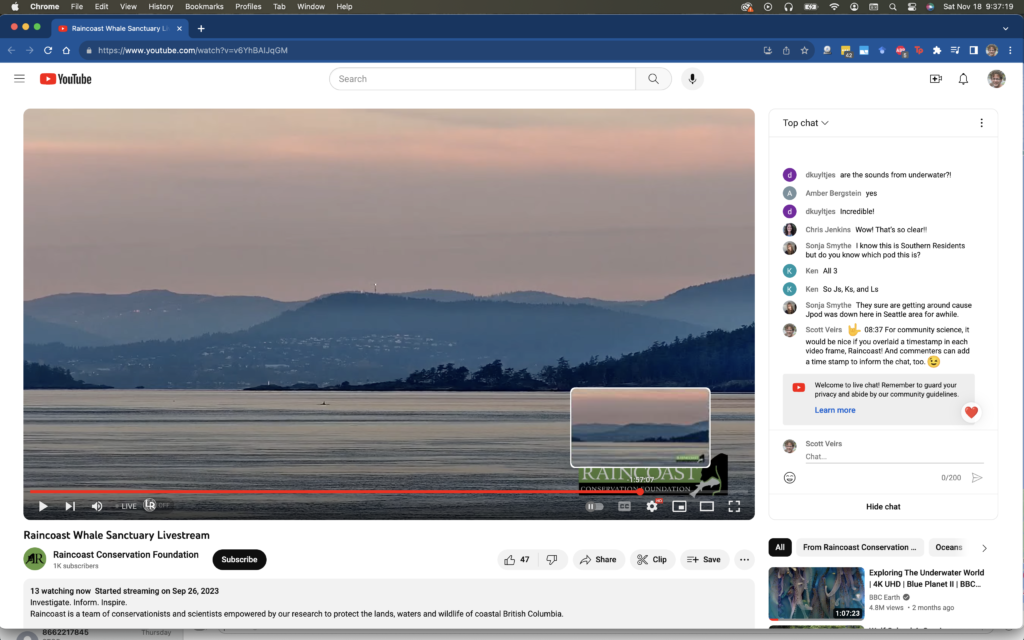
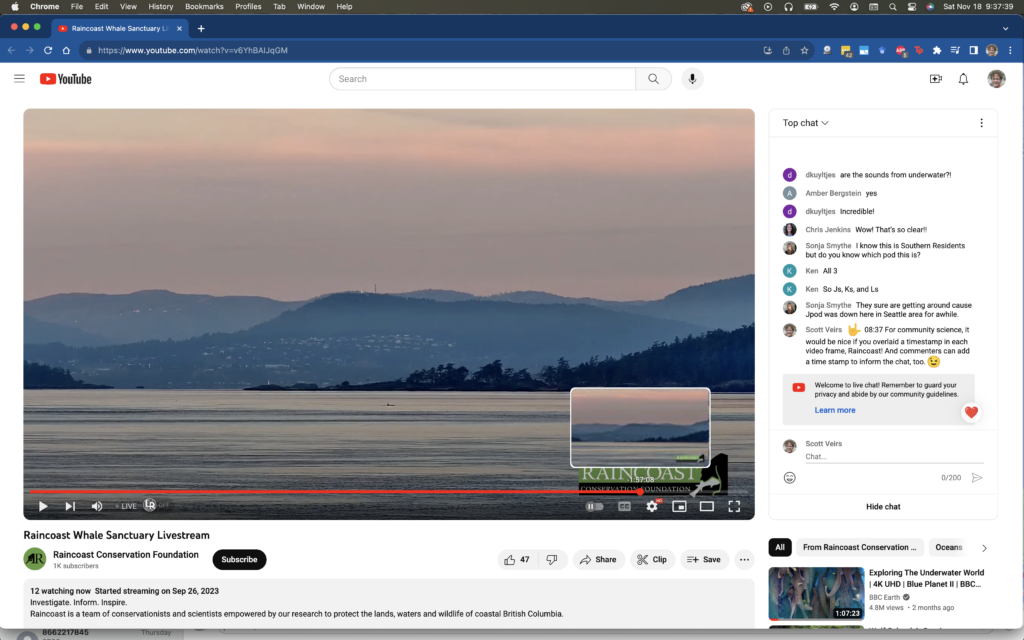

From this zoomed view it is possible to estimate the location of the camera on North Pender. By aligning the radio tower and observatory visible above Sidney (20 km away!) with the geography at the south end of Moresby Island —
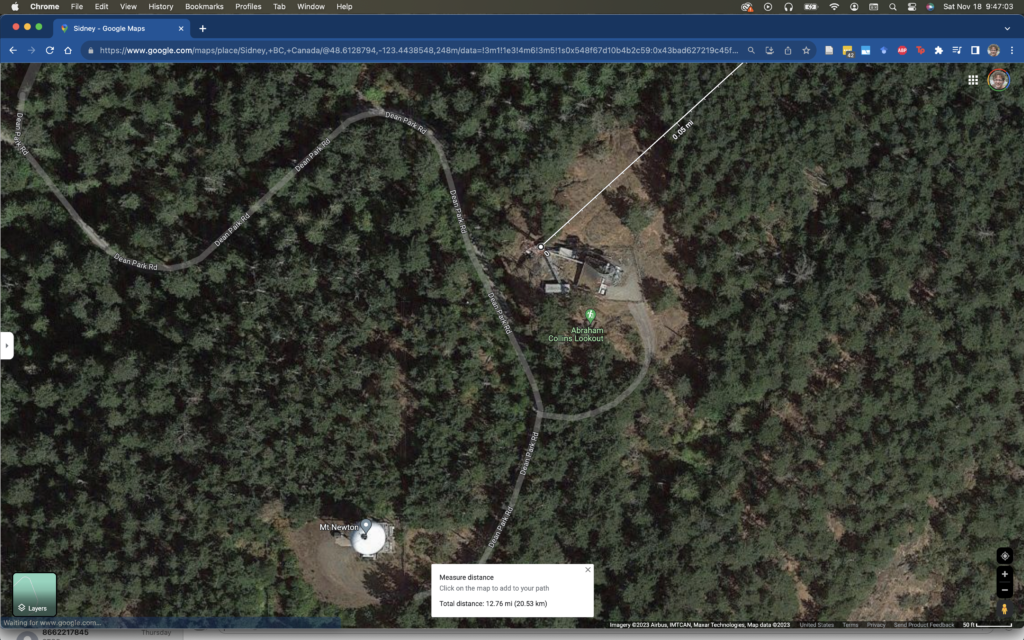

— we find a shoreside home…

…that has a field of view that matches what the camera shows when panned all the way left (looking south at Turn Point) and right (looking WNW to Saltspring Island):


Thus, we infer that the location has approximately this vantage point and listening/sighting window (see this view of the shared NE Pacific hydrophone map):

SIMRES = Saturna Island Marine Research & Education Society
TLDR; As 2023, SIMRES usually has a working mp3 near-live (6 minute lag?) stream from 1-2 hydrophones off eastern Saturn Island, but it is occasionally offline or appears to skip.
- Live MP3 stream embedded in SIMRES home page (scroll down to the HTML5 player)
- Direct link to stream: https://liveplatform.ca:8443/stream or https://liveplatform.ca:8443/stream.m3u (both work in Apple Music app on OSX) or https://liveplatform.ca:8443/stream.xspf (works in VLC on OSX
- Liveplatform.ca status page
- Liveplatform.ca stream info page
Update 11/18/2023: Right channel is streaming and seems consistent with passing ships visible via AIS sites, but the audio skips or stutters frequently.
Update 2/11/2023: SIMRES mp3 stream seems to be down. Also, just tried again to access any archived SIMRES data via ONC Oceans 3.0 data portal with no dice:

Update 1/4/2023, 11:00 Pacific: At least J pod northbound from last acoustic detection from Orcasound Lab are heard echolocating and calling by Monika Wieland Shields and Fred Horn (as reported via Facebook group Whale Sightings in the San Juans).
Update 11/11/2022, 12:30 Pacific: J+L pods northbound from Orcasound Lab rounding Turn Point, and Facebook folks notice that SIMRES live stream is down…
Update 10/21/2022: Just noticed that the SIMRES live stream status page has this note:
| Stream Description: | Live Stream from ṮEḴTEḴSEN (East Point, HF1288) and SNEUES (Monarch Head, HF6033), on left and right channels respectively. Audio is delayed 6 minutes from real time. |
Update 4/4/2022: As of late March, 2022, SIMRES is providing a live MP3 stream to the Saturna Island hydrophones (scroll down to the play button, or access direct link or liveplatform.ca stream info page). The location is listed as “ṮEḴTEḴSEN (East Point, Saturna Island)” but I think the stereo stream is presenting two channels: one from Monarch Head, the other from East Point.
Overview:
The Canadian NGO SIMRES, led first by Captain Larry Peck and more recently Martin Wale, maintains cabled icListen hydrophones deployed near the shoreline of ṮEḴTEḴSEN (Saturna Island, at East Point) and the next point to the south: SNEUES (Monarch Head). This is a magnificent vantage point for listening to the southern Strait of Georgia and Boundary Pass.

The Monarch Head hydrophone was redeployed in July, 2016. According to the ONC/DMAS metadata, the SIMRES-owned hydrophones are IClisten HF devices with GPS-based time synchronization. The sampling rates are 64 kHz for wav data and 256 kHz for power spectral density data. Data use requires SIMRES written permission.
- East Point
- Depth: 27m
- Lat:48° 46.8250′
- Long: -123° 03.0900′
- Monarch Head
- Depth: 20m
- Lat:48° 45.9970′
- Long: -123° 05.4610′
Despite my best efforts, I’ve not been able to access the data via the ONC archive. Selecting the hydrophone at either node results in this alert:

Perhaps one must contact SIMRES to listen? We’ll look into it further…
Orca Lab
TLDR; As 2023, Orcalab typically has at least one hydrophone stream live from the many sites they maintain in Johnstone Strait conveyed via radio links to Hanson Island and then on — either to an explore.org video+audio stream or older encoding schemes for live audio.
Update 11/18/23: OrcaLab YT livestream says it was last “live on Jul 7, 2023”
2023 listen-live link (YouTube livestream listed on whalesounds.ca site, new launched in 2023)
For nearly 50 years, Paul Spong and Helena Symonds of Orca Lab have maintained the Orca-Live hydrophone network in Johnstone Strait (at the north end of Vancouver Island). They have a diversifying array of ways to listen to the amazing marine soundscapes in which they live along with orcas, humpbacks, and even the occasional sperm whale (in 2018).
- Listen (and watch!) live (requires Windows Media Player)
- Listen live link (direct link to Realaudio stream via Japan service and orca-live chat room)
- OrcaLab’s Community chat room
- Explore.org cameras (with microphones); the underwater video streams sometimes include live audio from the hydrophones (but not at night, as of March, 2018).
- Orca Lab on Soundcloud
- Explore archive of digitized tapes through the Orchive (20,000 hours of recordings! But site when offline in 2010s?)
Ocean Networks Canada
TLDR; As of early 2023, ONC appears to offer no near real time hydrophones that are operational in the southern Strait of Georgia.
Update 2/11/2023: J pod went north through Active Pass this morning (at around 7:45 a.m. — we know thanks to the Salish Sea Orca Squad and Orca Behavior Institute), so I clicked through every Strait of Georgia hydrophone listed in ONC’s Hydrophone Viewer within the Oceans 3.0 Data Portal. Short story: it still really sucks! Longer story: it takes 3-10 seconds for the metadata to load for each of the ~50 past deployments. Then when did find a hydrophone that claims to still be deployed, the data archive suggests there are no data for the current/latest 24 hour period, so you get to do a directed random backward search to figure out when the latest data were archived. Here’s as close as I came to success:
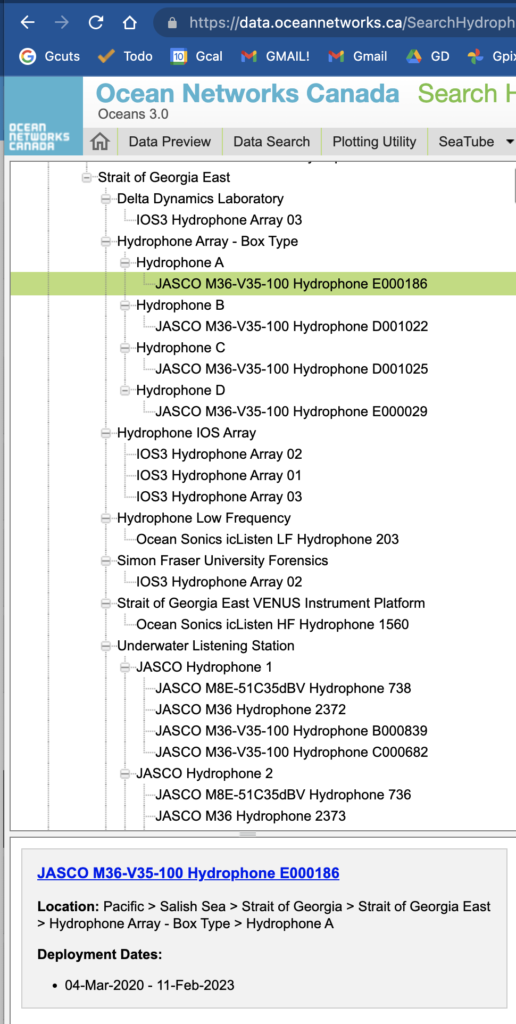


Update 1/4/2023: J pod (at least) went north past SIMRES around noon today, so I just checked to see if I could hear them this evening. The most recent 2022 data available from the Strait of Georgia hydrophone that worked last April (see below) is from 09 August, 2022.
Update 4/4/2022: ONC data access in near-real-time is available from within the Strait of Georgia via https://data.oceannetworks.ca/SearchHydrophoneData?LOCATION=233&DEVICE=24348&DATE=05-Apr-2022 and via the two SIMRES hydrophones (Monarch Head and East Point on Saturna Island, see SIMRES section below). Latency for the Strait of Georgia nodes seems to be about 1 hour and can be explored via the Oceans 3.0 hierarchical hydrophone data menu via “Strait of Georgia” –> “Strait of Georgia Central” –> “Strait of Georgia Venus Instrument Platform” –> “Ocean Sonics icListen AF Hydrophone 2548”) as in this screen shot:
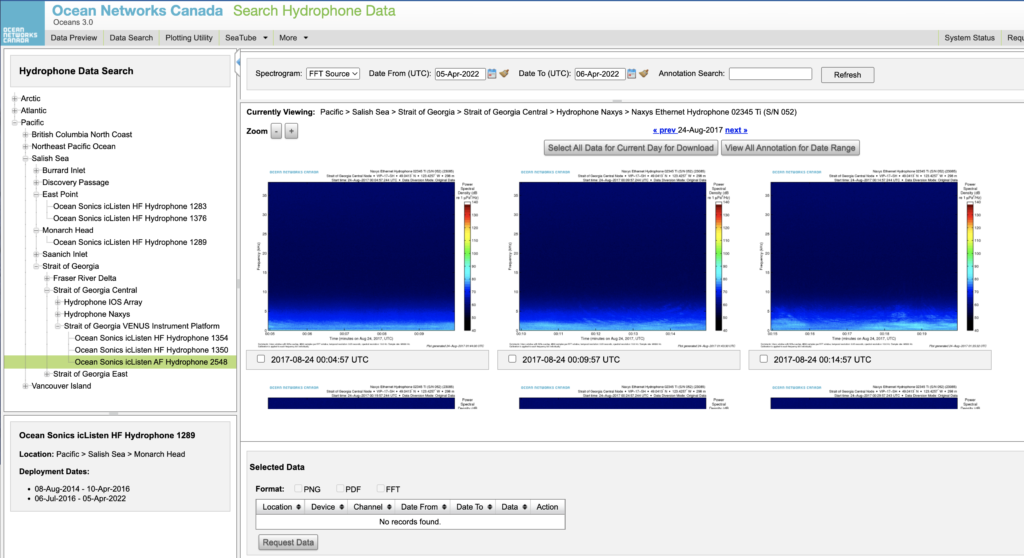
Old info/background:
Thanks to a helpful email from Tom Dakin, as of August 2017 these links provide access to a suite of hydrophones maintained around the southern coast of Vancouver Island on the Venus and Neptune lines by Ocean Networks Canada (ONC). To access the archived data (often near-realtime, with lags of 10-30 minutes), you need to register with their data management system (it’s free and easy). In very rare cases, data may have been redacted by Naval personnel.
| Site | Search hydrophone data page (search with spectrograms) | File download page (search by file name) |
| Strait of Georgia Central node | http://dmas.uvic.ca/SearchHydrophoneData?LOCATION=295&DEVICE=23085&DATE=24-Aug-2017 | http://dmas.uvic.ca/DataSearch?location=SGC.H2&deviceCategory=HYDROPHONE |
| Strait of Georgia East node | http://dmas.uvic.ca/SearchHydrophoneData?LOCATION=386&DEVICE=23938&DATE=24-Aug-2017 | http://dmas.uvic.ca/DataSearch?location=ECHO2.H2&deviceCategory=HYDROPHONE |
| Strait of Georgia Delta node | http://dmas.uvic.ca/SearchHydrophoneData?LOCATION=524&DEVICE=23818&DATE=24-Aug-2017 | http://dmas.uvic.ca/DataSearch?location=FAE&deviceCategory=HYDROPHONE |



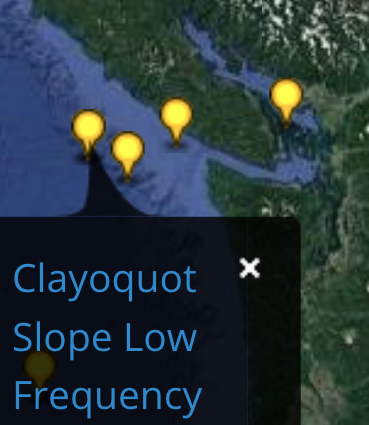


Pacific Wild
TLDR; The Pacific Wild live streams are no longer functioning.
Another great Canadian NGO, Pacific Wild, maintains the Great Bear Sea Hydrophone Network in partnership with the Heiltsuk First Nation. Based out of Bella Bella, BC, the network is an impressive deployment of hydrophones (and in many cases cameras) in a remote wilderness. As of 2012, this post describes their technological innovations.
In Spring 2017, they advertised for a technician with the skills to improve/fix their network… and their winter 2017 newsletter indicated that they were taking a break but planned to share recordings from 5 years of hard effort in 2018:

As of March 2018, I’m not able to find a live stream link on their site, but they have a wonderful archives:
BC Whales
NORTH COAST CETACEAN SOCIETY (BC Whales)
TLDR; The North and Central coast hydrophones in the BC Hydrophone Network do not offer live streams.
The BC Hydrophone Network offers online access to bioacoustic and noise overviews of their amazing archive of underwater recordings via the whalesounds.ca map, launched in summer, 2023. However there is no access to audio recordings, except through clips provide on the BC Whales page regarding whales and sound.

Previously, Janie Wray and Hermann Meuter of Cetacealab maintained a network of hydrophones on the northern BC coast. Their web site suggests they occasionally broadcast a live stream (via Flash or http://ghost.wavestreamer.com:4571/listen.pls for the record), but we’ve not witnessed it in action, likely due to the remote location, off-grid power system, and limited internet access.
Love watching Sun !
This information is priceless. When can I find out
I can’t figure out how to access the live feed. Can you help? Thanks. Cathy
Hi Cathy, if you’re talking about the live feeds for the three Orcasound hydrophones, here are the links to which you should point your favorite browser:
live.orcasound.net/orcasound-lab
live.orcasound.net/port-townsend
live.orcasound.net/bush-point
We still recommend Chrome for best performance on any operating system, though any browser should work.